Determination of Gold Particle Characteristics for Sampling Protocol Optimisation
Abstract
:1. Introduction
1.1. Sampling Optimisation
1.2. Gold Particle Sizing
1.3. Rationale, Focus and Content of This Paper
2. Theory of Sampling
2.1. Introduction to TOS
- (1)
- In situ representativity;
- (2)
- Sub-sample representativity.
2.2. Nugget Effect
- Geological (geological nugget effect: GNE) heterogeneity of the mineralisation.
- ∘
- Distribution of single grains or clusters of gold or sulphide-hosting gold particles distributed through the ore to larger continuous zones.
- ∘
- Continuity of structures such as high-grade gold carriers within the main structure or veinlets within wallrocks.
- Sampling induced error variability (sampling nugget effect: SNE).
- ∘
- Sample support (sample size—volume-variance).
- ∘
- Sample density (number of samples at a given spacing—information effect).
- ∘
- Sample collection, preparation, testwork and assay procedures.
2.3. Fundamental Sampling Error (FSE)
- What weight of sample should be taken from a larger mass of mineralisation, so that the FSE will not exceed a specified variance?
- What is the possible FSE when a sample of a given weight is obtained from a larger lot?
- Before a sample of given weight is drawn from a larger lot, what is the degree of crushing or grinding required to lower error to a specified FSE?
2.4. Gold Liberation Diameter and Clustering
2.4.1. Gold Liberation Diameter
2.4.2. Gold Clustering
2.4.3. Liberation Diameter or Cluster Diameter in the FSE Equation
2.4.4. Quantifying the Liberation Diameter
- Gold deportment assessment, in particular the partitioning of gold as free gold, gold in sulphides, and refractory gold;
- Gold particle size curve(s), including effects of clustering and relationship between gold particle size and grade (e.g., high-grade versus background grade);
- Definition of dℓAu and/or dℓclus.
2.5. Sample Quantity and Distribution
2.6. Representative In-Situ Sample Mass Estimation
2.7. Alternative Application of the Poisson Distribution
2.8. Data Quality Objectives, Decision Units and Fit-for-Purpose Data
3. Case Study: Crystal Hill Mine, Nick O’Time Shoot
3.1. Introduction
3.2. Geology and Mineralisation
3.3. Statistical and Spatial Characteristics of Gold Grade
3.4. Ore Characterisation: Thin Section and Hand Specimen Mineralogy and Metallurgical Composite Testwork
3.4.1. Mineralogy
3.4.2. Metallurgical Testwork
3.5. Descriptions of Samples Used for XCT Study
3.5.1. Introduction
3.5.2. Mineral Fills
3.5.3. Gold Appearance
4. XCT Scanning
4.1. Introduction to XCT
4.2. Data Acquisition, Image Processing and Validation
4.2.1. Data Acquisition and Image Processing
4.2.2. Validation
4.3. Example XCT Results from Samples B5 and B6
4.3.1. Sample B5
4.3.2. Sample B6
4.4. High Resolution XCT
5. Gold Particle Size Analysis: Integrating Mineralogical, Metallurgical and XCT Testwork
5.1. Limitations of the Testwork Methods Applied in This Study
5.2. XCT Data
5.3. Combined XCT, Metallurgical and Mineralogical Data
5.3.1. Visible-Gold Strongly Laminated Veins
5.3.2. No Visible-Gold Weakly Laminated Vein
5.4. Gold Distribution by Grade
5.5. Gold Distribution by Fraction in ROM Ore
5.6. Calculated Grade of XCT Samples
5.7. XCT Outcomes
6. Sampling Optimisation: In Situ Representative Sample Mass
6.1. Representative Sample Mass: Single Particle Liberation Diameter and Small Cluster (<5 mm) Scenarios
6.2. Representative Sample Mass: Ultra-High Grade Laminated Vein Gold Particle Clustering on Faces
6.3. Representative Sample Mass: Effects of Ultra-High Grade Laminated Vein Gold Particle Clustering
7. Grade Control Sampling, Sample Preparation and Assaying
7.1. Sampling Approach during Production
7.2. Sample Preparation and Assaying during Production
7.3. Field and Laboratory Duplicate Sample Pairs Analysis
7.4. Optimisation of the Sample Preparation and Assay Protocol
7.5. Actual Sample Mass Compared to RSM
7.6. Recommended Sampling Approach
7.6.1. Protocol
7.6.2. Sampling Protocol Cost and Value Proposition
8. Conclusions
8.1. General Conclusions
- Based on the case study presented, mine sampling practitioners can understand the inputs and analysis required to optimise sampling protocols. The approach presented can be applied to fine- or coarse-gold mineralisation to determine the nature of the gold particle sizing and make inferences about the mineralisation.
- Characterisation of gold mineralisation should be undertaken from the earliest opportunity, whether from diamond drill core or exposure sampling. Integrated programmes of mineralogical and metallurgical testwork provide a direct approach to evaluate the dℓAu and/or dℓclus, and gold particle size distribution. Any such programme has its limitations but will provide better results than more traditional heterogeneity testing.
- The impact of gold clustering should be evaluated, as it may be significant, influencing the RSM and increasing sample masses to tonnes or even tens of tonnes. Determination of dℓclus is no trivial matter and requires evaluation during surface and/or underground mapping and core logging. While the ultimate resolution of clustering is influenced by XCT, the gold particle size distribution and degree of clustering may vary across the mineralisation.
- XCT provides an opportunity to study the 3D distribution of gold, and in particular the resolution of clustering. XCT studies must include validation steps and other testwork to resolve gold particle size below the effective resolution.
8.2. Nick O’Time Shoot Conclusions
- The NOT was domained into low-grade spur vein and high-grade LVs. The LVs can be sub-divided into hangingwall and footwall vein domains, though they are geostatistically, mineralogically and texturally the same so were treated as one. More than 85% of the recovered gold came from the LVs which had a weighted mean grade of 140 g/t Au compared to 2.5 g/t Au for the spur veins. Grade shows a broad zoning, with higher grades in the upper portion of the shoot (>990 m level). Below the 990 m level grade reduces.
- NOT is typical of many nuggety deposits dominated by coarse gold where, at a ROM grade of 29 g/t Au, 92% of the contained gold occurs in 4% of the estimated total number of gold particles per tonne. This contrasts with the low-grade spur veins where 80% of the contained gold occurs in 99.8% of the estimated total number of gold particles per tonne. At the mean LV grade of 140 g/t Au, 98% of the contained gold occurs in 12% of the estimated total number of gold particles per tonne.
- Gold particle clustering on two scales was identified. In ROM and higher-grade mineralisation <5 mm (<65 mm3) scale clustering was observed in thin sections, and mine faces and drill core. At high- to ultra-high grades, >10 mm (>524 mm3) clusters were observed in samples scanned by XCT and field observation.
- XCT application proved to be effective in defining gold clusters. In addition to the thin section microscopy, it identified a spatial association between gold with arsenopyrite and/or galena. XCT resolved gold particle size to 200 µm, the population below which was defined by reflected light microscopy, metallurgical testwork and high-resolution XCT.
- LV single particle dℓAu value of 850 µm was recorded for the ROM, with local <5 mm clusters dℓclus values of <3000 µm. At the BCOG, the dℓAu value of 750 µm, with rare dℓclus values of 1500 µm. In high- to very-high grade mineralisation, the same single particle value is appropriate, though >1 cm large cluster dℓclus values range up to 12 cm. Spur veins yield a single particle dℓAu value of 250 µm.
- A background gold grade population of c. 5–6 g/t Au was identified in the LV domain. This material contains less coarse gold (25% between 200–525 µm) and possesses a dℓAu of 375 µm. Clustering is very rare. The estimated RSM is 5 kg.
- Given the distinctive grade and textural domains identified at NOT, the approach was taken to optimise RSM by domain (e.g., LV versus spur veins). RSM values for the LV ROM mineralisation are 5 kg for the single particle material, once 3 mm clustering occurs the RSM rises to 45 kg. At very high-grade mineralisation the RSM is 5–10 kg by virtue of the high grade. At the BCOG the RSM is 5–10 kg, and 7 kg for low grade mineralisation. For the ultra-high grade made up of abundant visible gold clusters, RSM values are <1 t and down to 100 kg. The biggest clusters are expected to relate to LV grades of >700 g/t Au for which the RSM is <550 kg.
- The proposed sampling protocol focusses on the economically gold-bearing LV domain. Larger area panel samples of around 11 kg (over a 0.7 m LV width, approximating to 15 kg per m) are recommended. Two preparation and assay options are suggested based on the PhotonAssay method. In both cases the sample is reduced to P90 −2 mm via a smart crusher, and then either split in half or retained whole. The −2 mm can then be directly assayed via PhotonAssay without the need for pulverising. The 50% sample split option gives reduced FSE values, and the 100% sample option gives a zero FSE. The removal of pulverising from the protocol is particularly valuable, as it reduces the potentially severe effect of the GSE in the presence of liberated gold.
9. Recommendations for the Mine Sampling Practitioner
- The sampling, sample preparation and assay process should aim to produce a variogram with a <50–60% nugget effect so that estimation variances are as low as possible. To achieve low-nugget variances, larger sample masses must be used when there is a high GNE. They will yield the best estimates of spatial correlation, which in turn will provide optimal SMU grade estimates.
- Characterisation must start as soon as mineralisation is encountered by outcrop (surface or underground) and/or drilling. At brownfield sites, review of historical information, including core, mapping and metallurgical data can provide data to drive the initial sampling and assaying campaigns. Preliminary dℓAu and/or dℓclus values may be identified and potential worst-case scenarios investigated
- Initial assaying campaigns should commence with screen fire assaying to identify the presence of coarse gold. This must be backed up by core/exposure logging/mapping to identify visible gold and gold associations. This stage will also identify if clusters are present.
- When mineralisation is physically accessible or enough core is available, undertake mini-bulk sampling (100–200 kg samples) and testwork, and integrate with mineralogical and metallurgical needs. Testwork should be based on a staged crush-liberation-concentration approach.
- Sample protocols should be reviewed on a scenario basis and accounting for the correlation of grade with dℓAu (or dℓclus). As a protocol progresses though sample comminution, consideration should be given to the change in dℓAu. Optimisation around the cut-off grade should be investigated as it may be the worst-case scenario.
- Practitioners should be justifiably critical of face sampling, given its potential for poor precision and high bias. However, it has a role to play in underground grade control, depending on its ultimate use. Maintaining representative samples is advantageous; however, there will always have to be a balance between what is theoretical, practical, and safe. It is important to understand what decisions the sample data will be used for, and the inherent risks involved in that decision process. The removal of face sampling will come from the use of pre-development drilling at a spacing to allow local estimation.
- Embrace new technologies such as smart crushers and PhotonAssay to achieve large volume assays in a cost-effective way. Any proposed protocol will require validation during initial implementation. This should include review of practical application; collection of duplicates; optimisation of grade control estimates; and reconciliation.
- There is a need to move towards the quantification of sampling and analytical errors to better communicate uncertainty and risk. A first step is the application of the protocol pro forma and RSV metric presented in Danish Standard DS3077 [61]. Resolution of component relative errors across sampling, preparation and analysis can be gained from the analysis of duplicate sample pairs.
Author Contributions
Funding
Data Availability Statement
Acknowledgments
Conflicts of Interest
Abbreviations
| AE | Analytical error |
| BCOG | Breakeven cut-off grade |
| CL | Confidence limits |
| DE | Delimitation error |
| dℓ or dℓAu | Liberation diameter |
| dℓclus | Clustered liberation diameter |
| DSA | Duplicate series analysis |
| DQO | Data quality objective |
| ESD | Equivalent spherical diameter |
| EE | Extraction error |
| FSE | Fundamental sampling error |
| GNE | Geological (or in situ) nugget effect |
| GRG | Gravity recoverable gold |
| GSE | Grouping and segregation error |
| HG | High grade |
| HT | Heterogeneity test |
| K | Sampling constant |
| LV | Laminated vein |
| MLV | Moderately laminated vein |
| NOT | Nick O’Time shoot |
| PE | Preparation error |
| RL | Relative level above a given reference horizon |
| ROM | Run of mine grade |
| RSM | Representative sample mass |
| RSV | Relative sampling variability |
| SLV | Strongly laminated vein |
| SMU | Selective mining (or decision) unit |
| SNE | Sampling nugget effect |
| TOS | Theory of Sampling |
| WE | Weighting error |
| WLV | Weakly laminated vein |
| XCT | X-ray computed tomography |
References
- Carrasco, P.C.; Carrasco, P.; Jara, E. The economic impact of incorrect sampling and analysis practices in the copper mining industry. Chemom. Intell. Lab. Syst. 2004, 74, 209–214. [Google Scholar] [CrossRef]
- Gy, P.M. Sampling of Particulate Materials: Theory and Practice; Elsevier: Amsterdam, The Netherlands, 1982; p. 431. [Google Scholar]
- Minnitt, R.C.A. Sampling: The impact on costs and decision making. J. S. Afr. Inst. Min. Metall. 2007, 107, 451–462. [Google Scholar]
- Dominy, S.C. Importance of good sampling practice throughout the gold mine value chain. Mining Tech. 2016, 125, 129–141. [Google Scholar] [CrossRef]
- Lyman, G.J.; Bourgeois, F.S. Sampling, corporate governance and risk analysis. In We Are Metallurgists Not Magicians: Landmark Papers by Practicing Metallurgists; The Australasian Institute of Mining and Metallurgy: Melbourne, VIC, Australia, 2017; pp. 349–354. [Google Scholar]
- Dominy, S.C.; O’Connor, L.; Purevgerel, S. Importance of representative metallurgical sampling and testwork programmes to reduce project risk—A gold case study. Mining Tech. 2019, 128, 230–245. [Google Scholar] [CrossRef]
- Pitard, F.F. Theory of Sampling and Sampling Practice; CRC Press: Boca Raton, FL, USA, 2019; p. 694. [Google Scholar]
- Royle, A.G. Splitting gold assay pulps containing coarse gold. J. Leeds Univ. Min. Assoc. 1989, 89, 63–68. [Google Scholar]
- Johansen, G.F.; Dominy, S.C. Development of Sampling Protocols at the Bendigo Gold Project, Australia. In Proceedings of the World Conference on Sampling and Blending, Sunshine Coast, QLD, Australia, 10–12 May 2005; Australasian Institute of Mining and Metallurgy: Melbourne, VIC, Australia, 2005; pp. 175–183. [Google Scholar]
- Cintra, E.C.; Scabora, J.A.; Viegas, E.P.; Barata, R.; Maia, G.F. Coarse Gold Sampling at Sao Francisco Mine, Brazil. In Proceedings of the World Conference on Sampling and Blending, Porto Alegre, Brazil, 23–25 October 2007; Fundacao Luiz Englert: Porto Alegre, Brazil, 2007; pp. 187–197. [Google Scholar]
- Dominy, S.C. Predicting the unpredictable–evaluating high-nugget effect gold deposits. In Mineral Resource and Ore Reserve Estimation Guide to Good Practice; Australasian Institute of Mining and Metallurgy: Melbourne, VIC, Australia, 2014; pp. 659–678. [Google Scholar]
- Dominy, S.C. Sampling Coarse Gold-Bearing Mineralisation–Developing Effective Protocols and a Case Study from the Ballarat Mine, Australia. In Proceedings of the World Conference on Sampling and Blending, Perth, WA, Australia, 9–1 May 2017; Australasian Institute of Mining and Metallurgy: Melbourne, VIC, Australia, 2017; pp. 71–84. [Google Scholar]
- Gonzalez, P.; Cossio, S. A Review of Sampling Protocol for a Gold Ore Based on Liberation Study. In Proceedings of the World Conference on Sampling and Blending, Porto Alegre, Brazil, 23–25 October 2007; Fundacao Luiz Englert: Porto Alegre, Brazil, 2007; pp. 163–174. [Google Scholar]
- Pitard, F.F. The Advantages and Pitfalls of Conventional Heterogeneity Tests and a Suggested Alternative. In Proceedings of the World Conference on Sampling and Blending, Bordeaux, France, 10–12 June 2015; IM Publications LLP: Chichester, UK, 2015; pp. 13–18. [Google Scholar]
- Villanova, F.L.S.P.; Heberle, A.; Chieregati, A.C. Heterogeneity Tests and Core Logging—A Final Reconciliation. In Proceedings of the World Conference on Sampling and Blending, Perth, WA, Australia, 9–11 May 2017; Australasian Institute of Mining and Metallurgy: Melbourne, VIC, Australia, 2017; pp. 107–113. [Google Scholar]
- Dominy, S.C.; Platten, I.M.; Xie, Y.; Minnitt, R.C.A. Underground grade control protocol design: Case study from the Liphichi gold project, Larecaja, Bolivia. Appl. Earth Sci. 2011, 119, 205–219. [Google Scholar] [CrossRef]
- Dominy, S.C.; O’Connor, L.; Glass, H.J.; Purevgerel, S. Xie, Y. Towards representative metallurgical sampling and recovery testwork programmes. Minerals 2018, 8, 193. [Google Scholar] [CrossRef] [Green Version]
- Arkenbout, A.; Brochot, S.; Esbensen, K.H.; Minkkinen, P.; Holmes, R.J.; Huachang, L.; Dominy, S.C.; Mingwei, Z.; Romanach, R.J.; Robben, C.; et al. Economic arguments for representative sampling. Spectrosc. Eur. 2021, 33. in press. [Google Scholar]
- Dominy, S.C.; Platten, I.M. Clustering of gold particles and implications for sampling. Appl. Earth Sci. 2007, 116, 130–142. [Google Scholar] [CrossRef]
- Dominy, S.C.; Xie, Y.; Platten, I.M. Gold Particle Characteristics in Narrow Vein Deposits: Implications for Evaluation and Metallurgy. In Proceedings of the Narrow Vein Mining Conference, Ballarat, VIC, Australia, 14–15 October 2008; Australasian Institute of Mining and Metallurgy: Melbourne, VIC, Australia, 2008; pp. 91–104. [Google Scholar]
- Pitard, F.F. The In-situ Nugget Effect: A Major Component of the Random Term of a Variogram. In Proceedings of the World Conference on Sampling and Blending, Porto Alegre, Brazil, 23–25 October 2007; Fundacao Luiz Englert: Porto Alegre, Brazil, 2007; pp. 91–110. [Google Scholar]
- Dominy, S.C.; Petersen, J.S. Sampling Coarse Gold-Bearing Mineralisation-Developing Effective Protocols and a Case Study from the Nalunaq Mine, Southern Greenland. In Proceedings of the World Conference on Sampling and Blending, Sunshine Coast, QLD, Australia, 10–12 May 2005; Australasian Institute of Mining and Metallurgy: Melbourne, VIC, Australia, 2005; pp. 151–165. [Google Scholar]
- Dominy, S.C.; Purevgerel, S.; Esbensen, K.H. Quality and sampling error quantification for gold mineral resource estimation. Spectroscopy Europe 2020, 32, 21–27. [Google Scholar]
- Lyman, G.J. and Esbensen, K.H. Critique of Gy’s Sampling Theory–Misplaced expectations of Wikipedia’s democratic intentions. TOS Forum 2013, 1, 28–30. [Google Scholar]
- Esbensen, K.H. Introduction to the Theory and Practice of Sampling; IM Publications: Chichester, UK, 2020; p. 328. [Google Scholar]
- François-Bongarçon, D.M. Theory of sampling and geostatistics: An intimate link. Chemom. Intell. Lab. Syst. 2004, 74, 143–148. [Google Scholar] [CrossRef]
- Pitard, F.F.; François-Bongarçon, D.M. Demystifying the Fundamental Sampling Error and the Grouping and Segregation Error for Practitioners. In Proceedings of the World Conference on Sampling and Blending, Santiago, Chile, 25–28 October 2011; GECAMIN: Santiago, Chile, 2011; pp. 39–56. [Google Scholar]
- François-Bongarçon, D.M.; Gy, P.M. The most common error in applying Gy’s formula in the theory of mineral sampling and the history of the Liberation factor. J. S. Afr. Inst. Min. Metall. 2002, 102, 475–479. [Google Scholar]
- François-Bongarçon, D.M. Extensions to the demonstration of Gy’s formula. Explor. Min. Geol. 1998, 7, 149–154. [Google Scholar]
- Minnitt, R.C.A.; Rice, P.; Spangenberg, C. Experimental calibration of sampling parameters K and alpha for Gy’s formula by the sampling tree method. J. S. Afr. Inst. Min. Metall. 2007, 107, 513–518. [Google Scholar]
- Minnitt, R.C.A.; Assibey-Bonsu, W. A Comparison between the Duplicate Series Method and the Heterogeneity Test as Methods for Calculating Gy’s Sampling Constants, K and Alpha. In Proceedings of the World Conference on Sampling and Blending, Cape Town, South Africa, 21–23 October 2009; Southern African Institute of Mining and Metallurgy: Johannesburg, South Africa, 2009; pp. 137–154. [Google Scholar]
- Pitard, F.F. Practical and theoretical difficulties when sampling gold. In Proceedings Mineral Processing Plant Design, Practice and Control; SME: Littleton, CO, USA, 2002; pp. 77–89. [Google Scholar]
- Bazin, C.; Hodouin, D.; Mermillod-Blondin, R. Reproducibility of Low-Grade Ore Batches Prepared for Metallurgical Testing. In Proceedings of the World Conference on Sampling and Blending, Santiago, Chile, 10–12 July 2013; Gecamin: Santiago, Chile, 2013; pp. 419–433. [Google Scholar]
- Dominy, S.C.; Xie, Y. Optimising sampling protocols via the heterogeneity test: Challenges in coarse gold mineralisation. Mining Tech. 2016, 125, 103–113. [Google Scholar] [CrossRef]
- Minnitt, R.C.A.; Francois-Bongarçon, D.M.; Pitard, F.F. Segregation Free Analysis for Calibrating the Constants K and Alpha for Use in Gy’s Formula. In Proceedings of the World Conference on Sampling and Blending, Santiago, Chile, 25–28 October 2011; GECAMIN: Santiago, Chile, 2011; pp. 133–150. [Google Scholar]
- Dominy, S.C.; Platten, I.M.; Howard, L.E.; Xie, Y.; Bell, R.F.; Minnitt, R.C.A. Determination of the Sampling Liberation Diameter in a High-Grade Coarse Gold Ore by High-Resolution X-Ray Computed Tomography. In Proceedings of the Sampling Conference, Perth, WA, Australia, 21–22 August 2012; Australasian Institute of Mining and Metallurgy: Melbourne, VIC, Australia, 2012; pp. 161–169. [Google Scholar]
- Clifton, H.E.; Hunter, R.E.; Swanson, F.J.; Phillips, R.L. Sample Size and Meaningful Gold Analysis, Professional Paper 625-C; United States Geological Survey: Washington, DC, USA, 1969; p. 19.
- Stanley, C.R. Nugget calculation parameters for samples and elements affected by the nugget effect. Explor. Min. Geol. 1998, 7, 139–147. [Google Scholar]
- Stanley, C.R.; Smee, B.W. Strategies for reducing sampling errors in exploration and resource definition drilling programmes for gold deposits. Geochem. Explor. Env. Anal. 2007, 7, 1–12. [Google Scholar] [CrossRef]
- François-Bongarçon, D.M. Fishy Samples: How Big a Sample to Avoid the Infamous Poisson Effect. In Proceedings of the World Conference on Sampling and Blending, Cape Town, South Africa, 21–23 October 2009; Southern African Institute of Mining and Metallurgy: Johannesburg, South Africa, 2009; pp. 43–46. [Google Scholar]
- Villanova, F.L.S.P.; Chieregati, A.C. The use of equant grain particles to validate analytical sample size in gold deposits—A case study. Chemo. Intell. Lab. Syst. 2018, 181, 36–44. [Google Scholar] [CrossRef]
- Dominy, S.C.; Platten, I.M.; Xie, Y. Determining Gold Particle Size in Gravity Ores for Sampling and Metallurgical Characterisation–Discussion and Test Protocol. In Proceedings of the Gravity Gold Conference, Ballarat, Australia, 21–22 September 2010; Australasian Institute of Mining and Metallurgy: Melbourne, VIC, Australia, 2010; pp. 83–95. [Google Scholar]
- Mariano, R.A.; Evans, C.L. Error analysis in ore particle composition distribution measurements. Mins. Eng. 2015, 82, 36–44. [Google Scholar] [CrossRef]
- Pitard, F.F. Guidelines for Acceptable Allotted Sampling Uncertainty. In Proceedings of the World Conference on Sampling and Blending, Santiago, Chile, 10–12 July 2013; Gecamin: Santiago, Chile, 2013; pp. 89–98. [Google Scholar]
- Graindorge, J. Maintaining Sample Data Quality through Robust Quality Assurance and Quality Control Protocols. In Proceedings of the Sampling Conference, Perth, Australia, 11–12 May 2010; Australasian Institute of Mining and Metallurgy: Melbourne, VIC, Australia, 2010; pp. 111–116. [Google Scholar]
- Wilson, J.L.; Moore, D.H.; Vollgger, S.A.; Madeley, H.E. Structural evolution of the orogenic gold deposits in central Victoria, Australia. Ore Geol. Rev. 2020, 120, 103390. [Google Scholar] [CrossRef]
- B.W. Tarnagulla Mineralisation Report Including a Grade and Tonnage Estimate for the Nick O’Time Shoot; Unpublished Report for Castlemaine Goldfields Ltd.: Ballarat, VIC, Australia, 2013; p. 45. [Google Scholar]
- McCarthy, P.L.; Faulkner, L. Tarnagulla Gold Mine. In Proceedings of the Narrow Vein Mining Conference, Ballarat, VIC, Australia, 14–15 October 2008; Australasian Institute of Mining and Metallurgy: Melbourne, VIC, Australia, 2008; pp. 237–248. [Google Scholar]
- Krokowski de Vickerod, J.; Cuffley, B.W.; Evans, T. Tarnagulla Goldfield, Central Victoria. In Victorian Initiative for Minerals and Petroleum Report No 71; Minerals and Petroleum Victoria: Melbourne, VIC, Australia, 2001; p. 160. Available online: http://earthresources.efirst.com.au/product.asp?pID=542&cID=8 (accessed on 28 September 2021).
- Cuffley, B.W.; Krokowski de Vickerod, J.; Evans, T.; Fraser, R. A new structural model for fault-hosted gold mineralisation: An example from the Nick O’Time ore shoot, Poverty Reef, Tarnagulla. In Developments in Victorian Geology and Mineralisation; Australasian Institute of Geoscientists Bulletin No. 24: Perth, WA, Australia, 1998; pp. 53–63. [Google Scholar]
- Laplante, A.R. Report on the Characterization of Gravity Recoverable Gold in a Sample of Reef Mining NL Ore. In Unpublished Report by the Department of Mining and Metallurgical Engineering; McGill University: Montreal, QC, Canada, 1998; p. 15. [Google Scholar]
- Chisambi, J.; von der Heyden, B.; Tshibalanganda, M.; Le Roux, S. Gold exploration in two and three dimensions: Improved and correlative insights from microscopy and X-ray computed tomography. Minerals 2020, 10, 476. [Google Scholar] [CrossRef]
- Kyle, J.R.; Ketcham, R.A. Application of high-resolution X-ray computed tomography to mineral deposit origin, evaluation and processing. Ore Geol. Rev. 2015, 65, 821–839. [Google Scholar] [CrossRef]
- Guntoro, P.I.; Ghorbani, Y.; Butcher, A.R.; Kuva, J.; Rosenkranz, R. Textural quantification and classification of drill cores for geometallurgy: Moving toward 3D with X-ray microcomputed tomography. Nat. Res. Res. 2020, 29, 3547–3565. [Google Scholar] [CrossRef]
- Howard, L.E.; Elangovan, P.; Abel, R.L.; Dominy, S.C.; Armstrong, R. Characterisation of Gold Ores by X-Ray Micro-Computer Tomography Part 1: Software for Calibration and Quantification of Mineralogical Phases. In Proceedings of the International Geometallurgy Conference, Brisbane, Australia, 5–7 September 2011; Australasian Institute of Mining and Metallurgy: Melbourne, VIC, Australia, 2011; pp. 321–330. [Google Scholar]
- Minnitt, R.C.A.; Collins, D.; Whitten, W.; Gay, S.L.; Louwrens, E.; Morrison, R. Comparison of the Liberation Size Determined by Different Methods. In Proceedings of the World Conference on Sampling and Blending, Porto Alegre, Brazil, 23–27 October 2007; Fundacao Luiz Engler: Porto Alegre, Brazil, 2007; pp. 253–267. [Google Scholar]
- Dominy, S.C.; Murphy, B.; Gray, A.H. Characterisation of Gravity Amenable Gold Ores–Sample Representativity and Determination Methods. In Proceedings of the International Geometallurgy Conference, Brisbane, QLD, Australia, 5–7 September 2011; Australasian Institute of Mining and Metallurgy: Melbourne, VIC, Australia, 2011; pp. 281–292. [Google Scholar]
- Dominy, S.C.; O’Connor, L.; Glass, H.J.; Xie, Y. Geometallurgical study of a gravity recoverable gold orebody. Minerals 2018, 8, 186. [Google Scholar] [CrossRef] [Green Version]
- Dominy, S.C.; Glass, H.J.; Lam, C.K.; O’Connor, L.; Purevgerel, S.; Minnitt, R.C.A. Integrating the Theory of Sampling into underground grade control strategies. Minerals 2018, 8, 232. [Google Scholar] [CrossRef] [Green Version]
- Tremblay, C.D.; Tickner, J.; Treasure, D.; Oteri, A.; Wheeler, G. PhotonAssay–Efficient and Bulk Gold Analysis in the Modern World. In Proceedings of the International Mining Geology Conference, Perth, WA, Australia, 25–26 November 2019; Australasian Institute of Mining and Metallurgy: Melbourne, VIC, Australia, 2019; pp. 88–98. [Google Scholar]
- DS3077. Representative Sampling–Horizontal Standard; Danish Standards Foundation: Copenhagen, Denmark, 2013; p. 41. [Google Scholar]
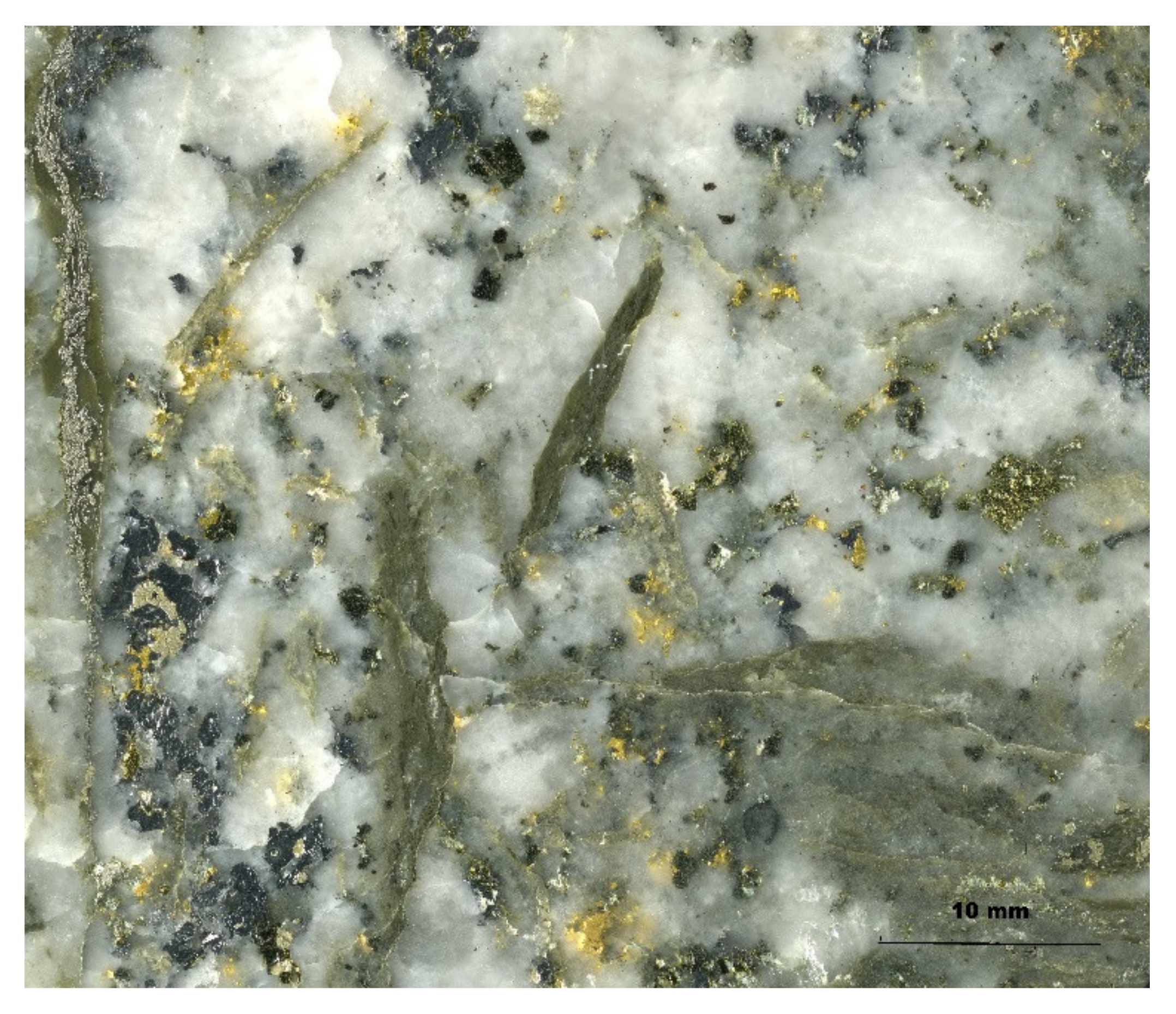
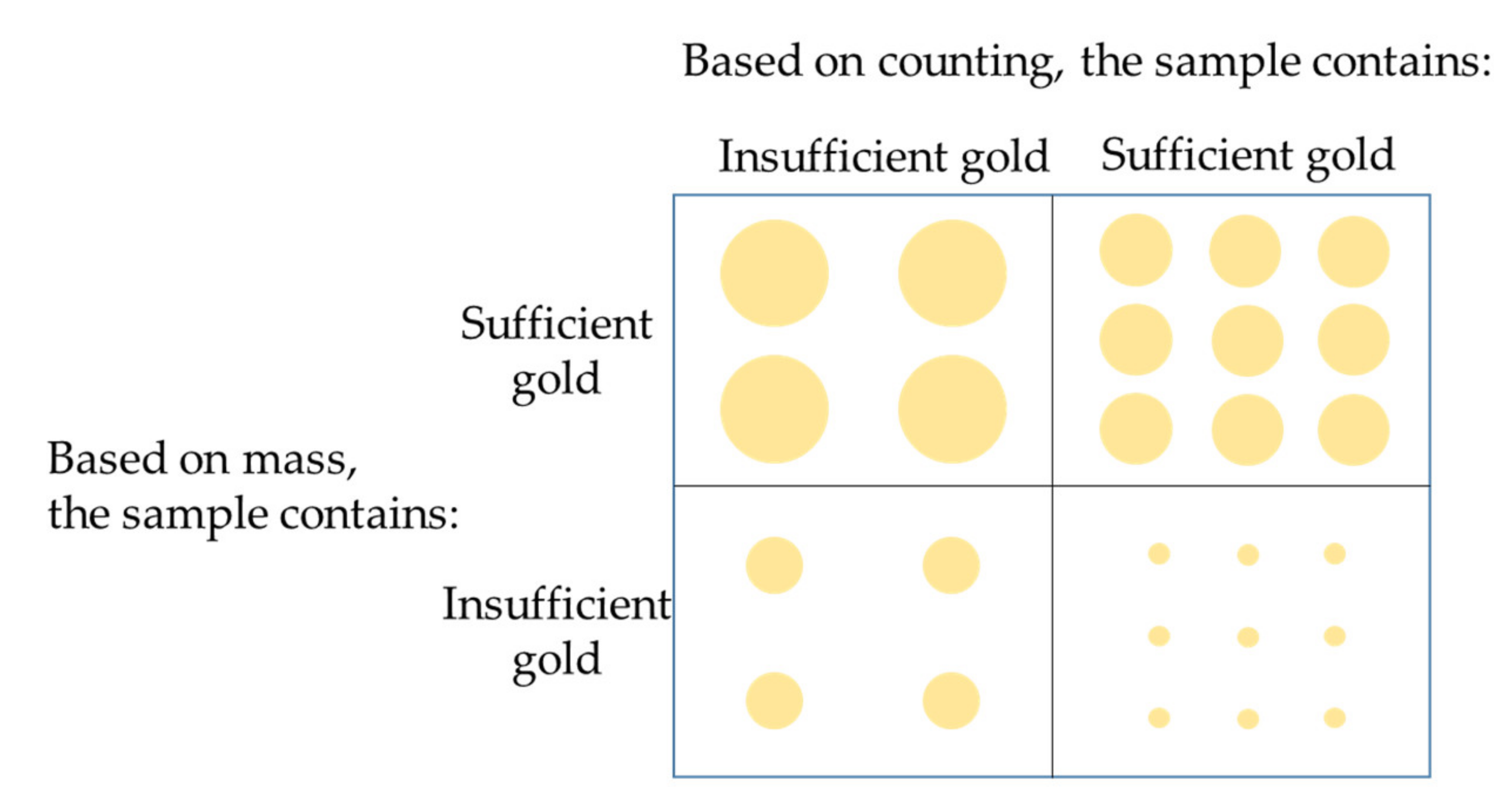
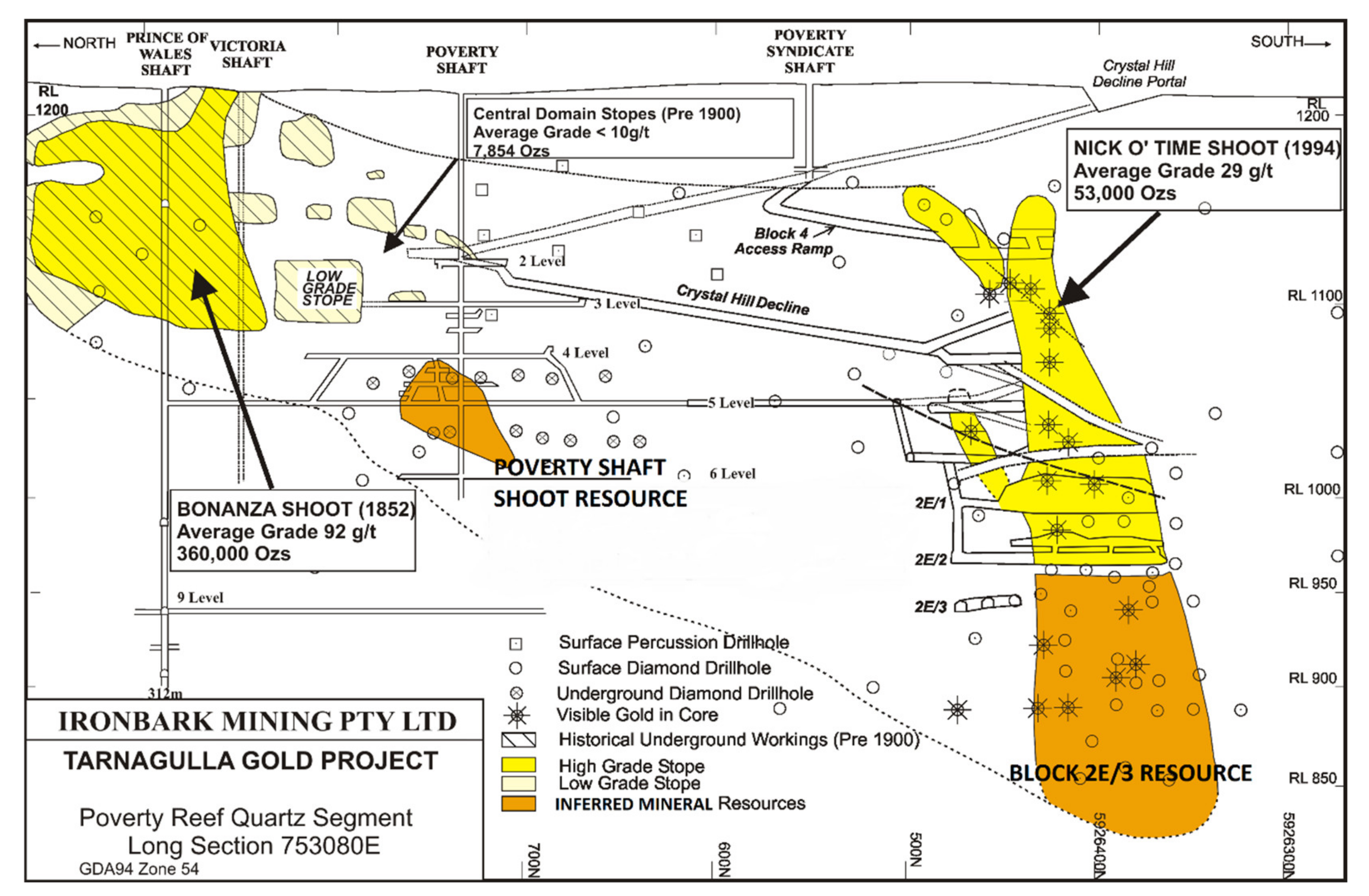
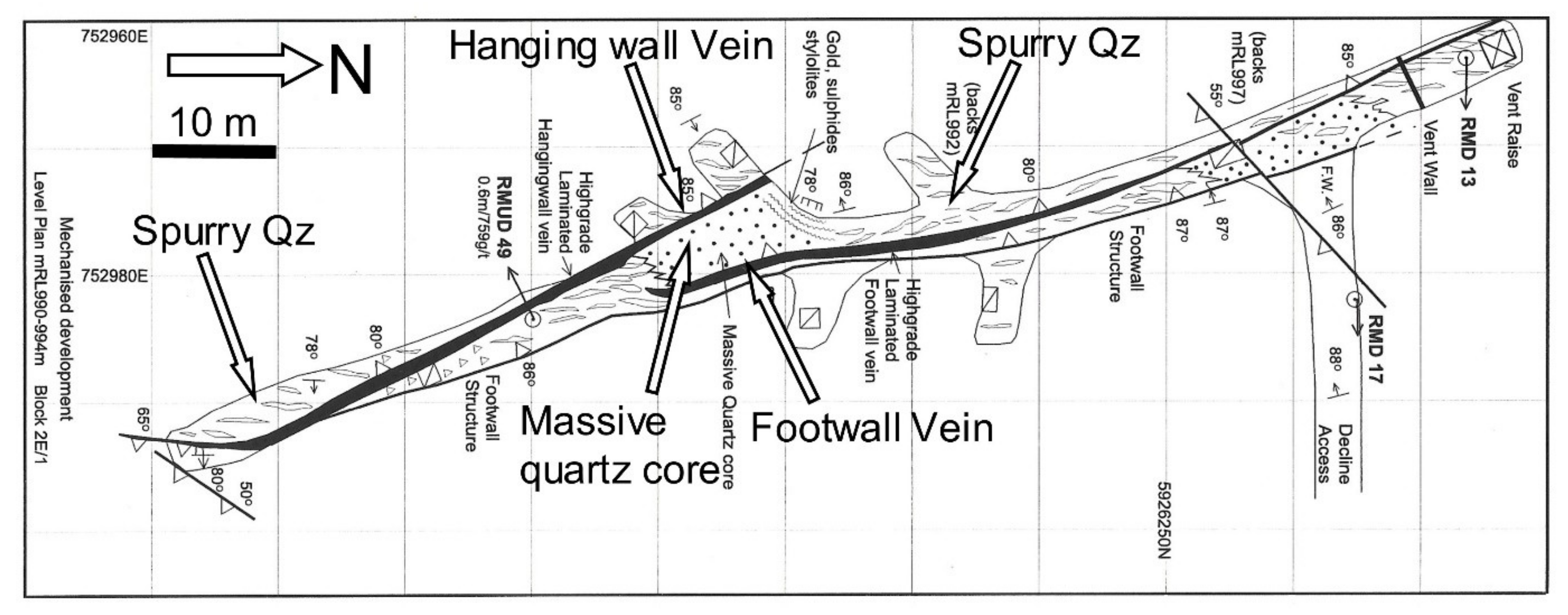
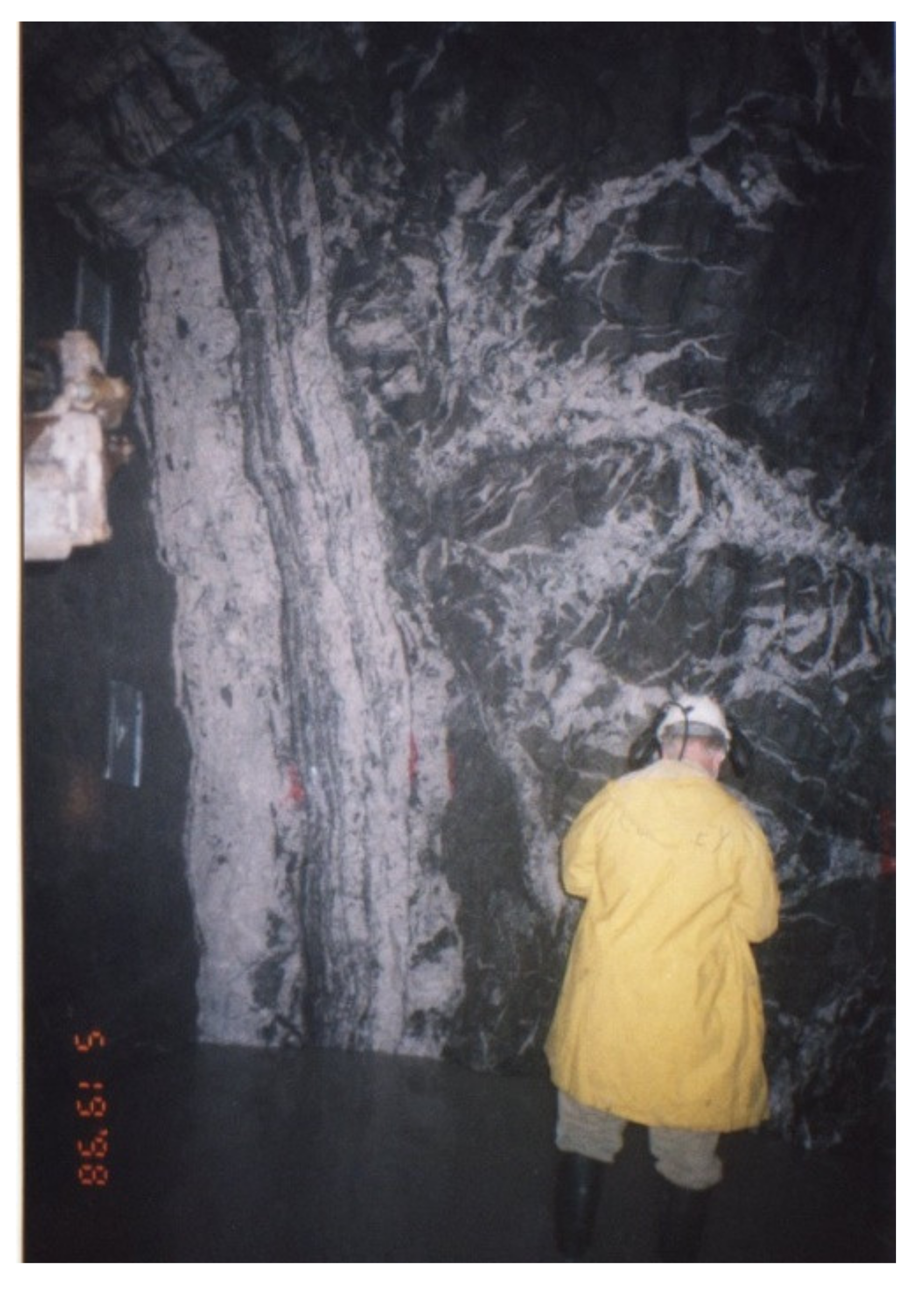
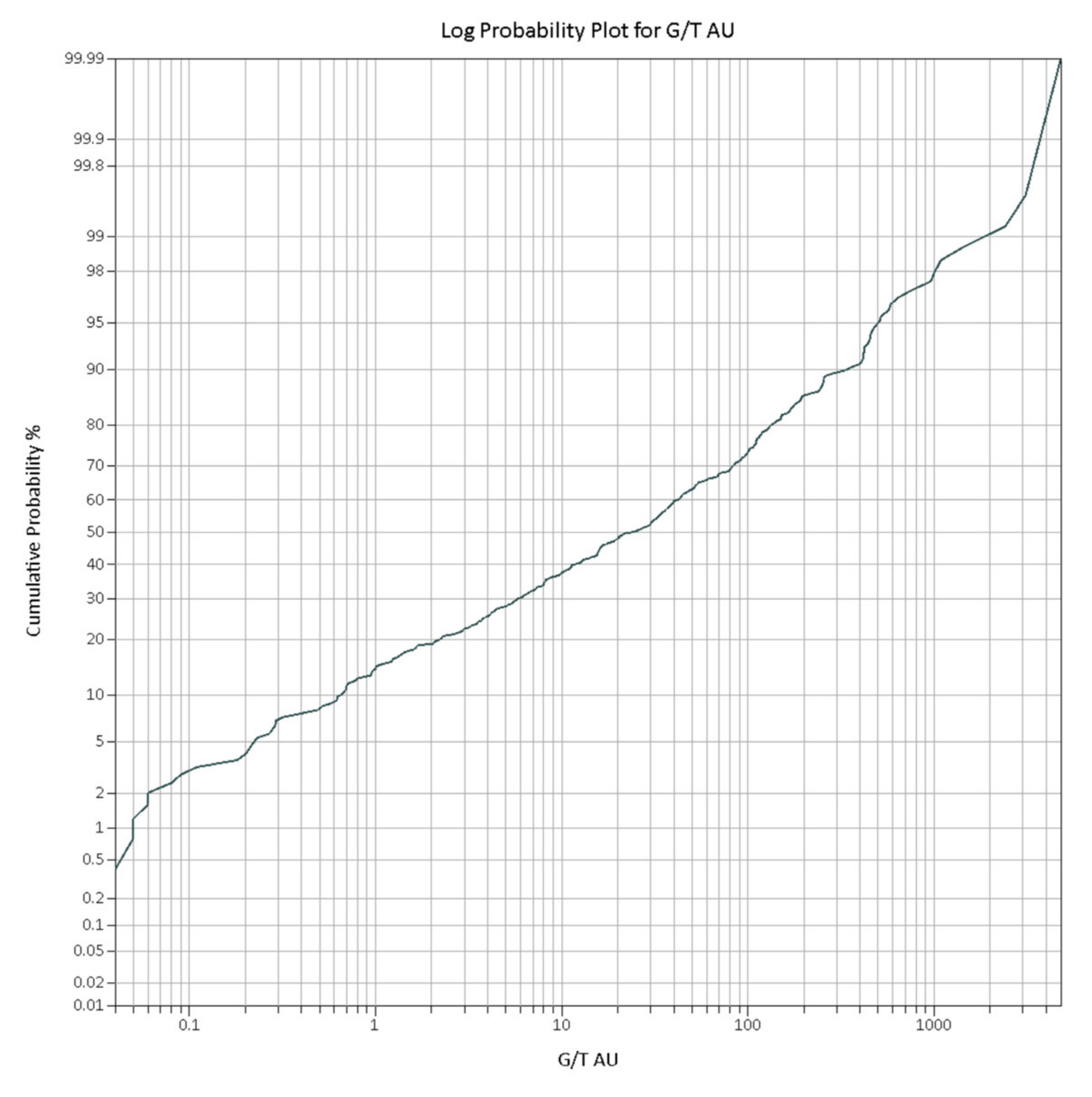
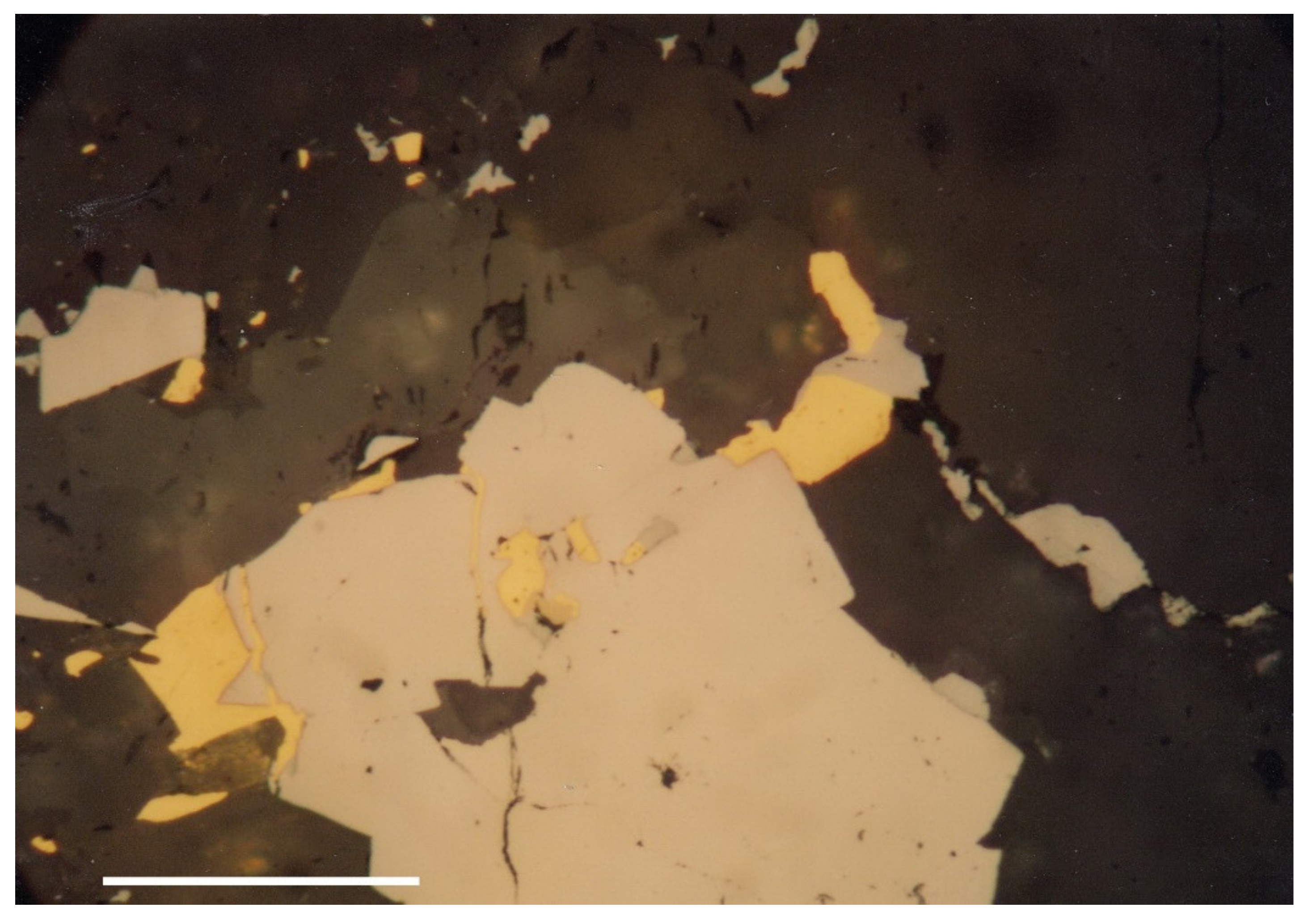
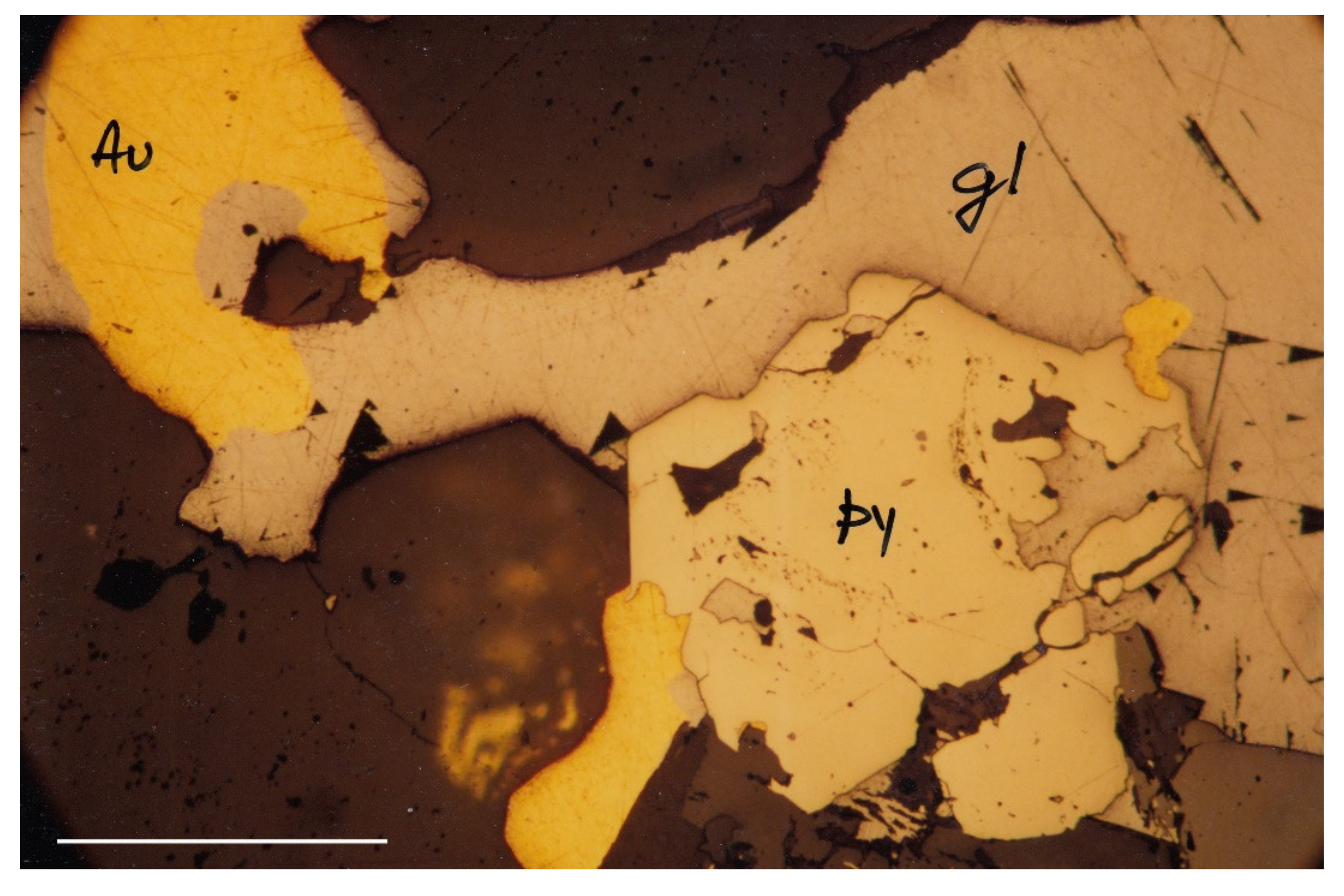
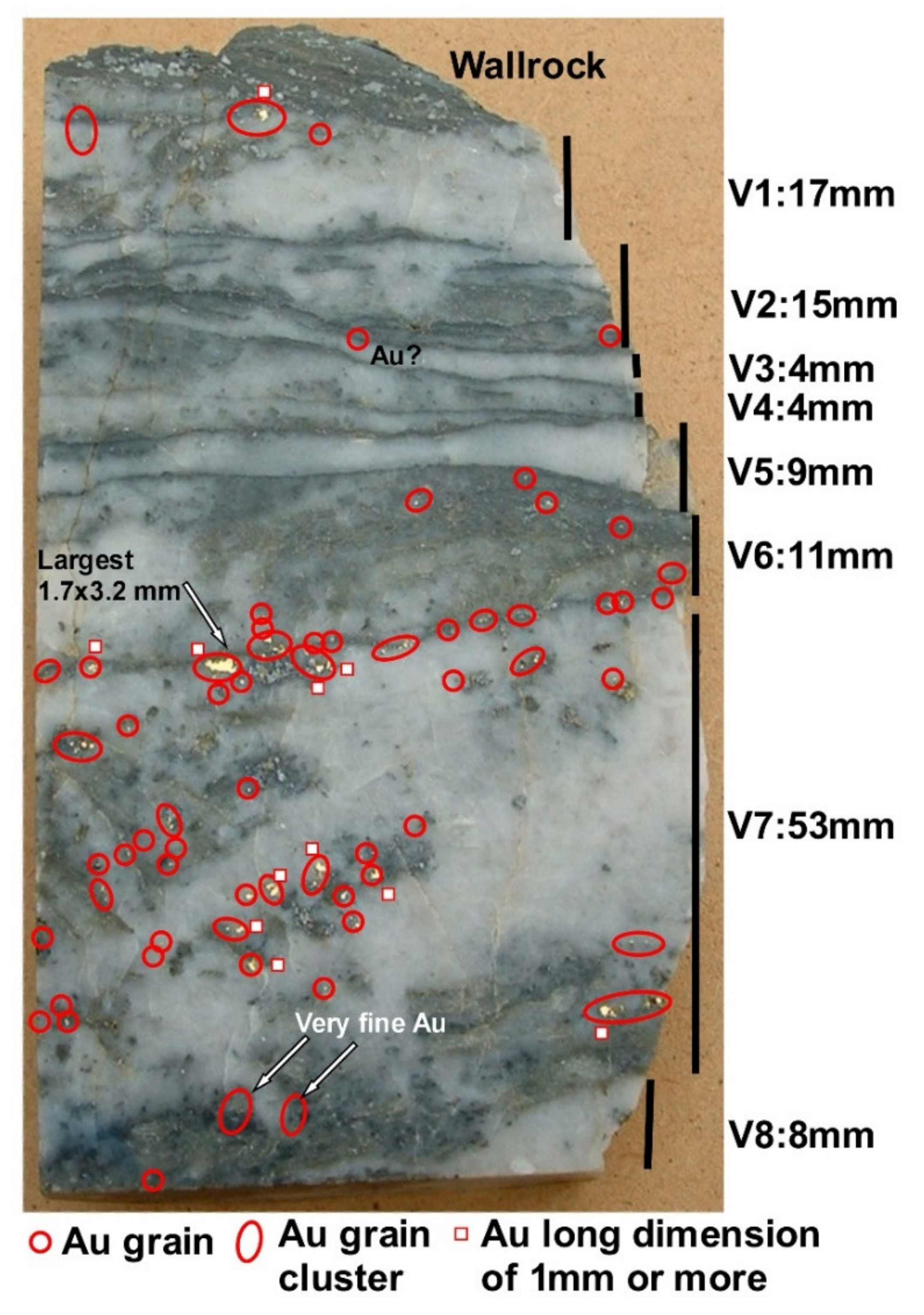
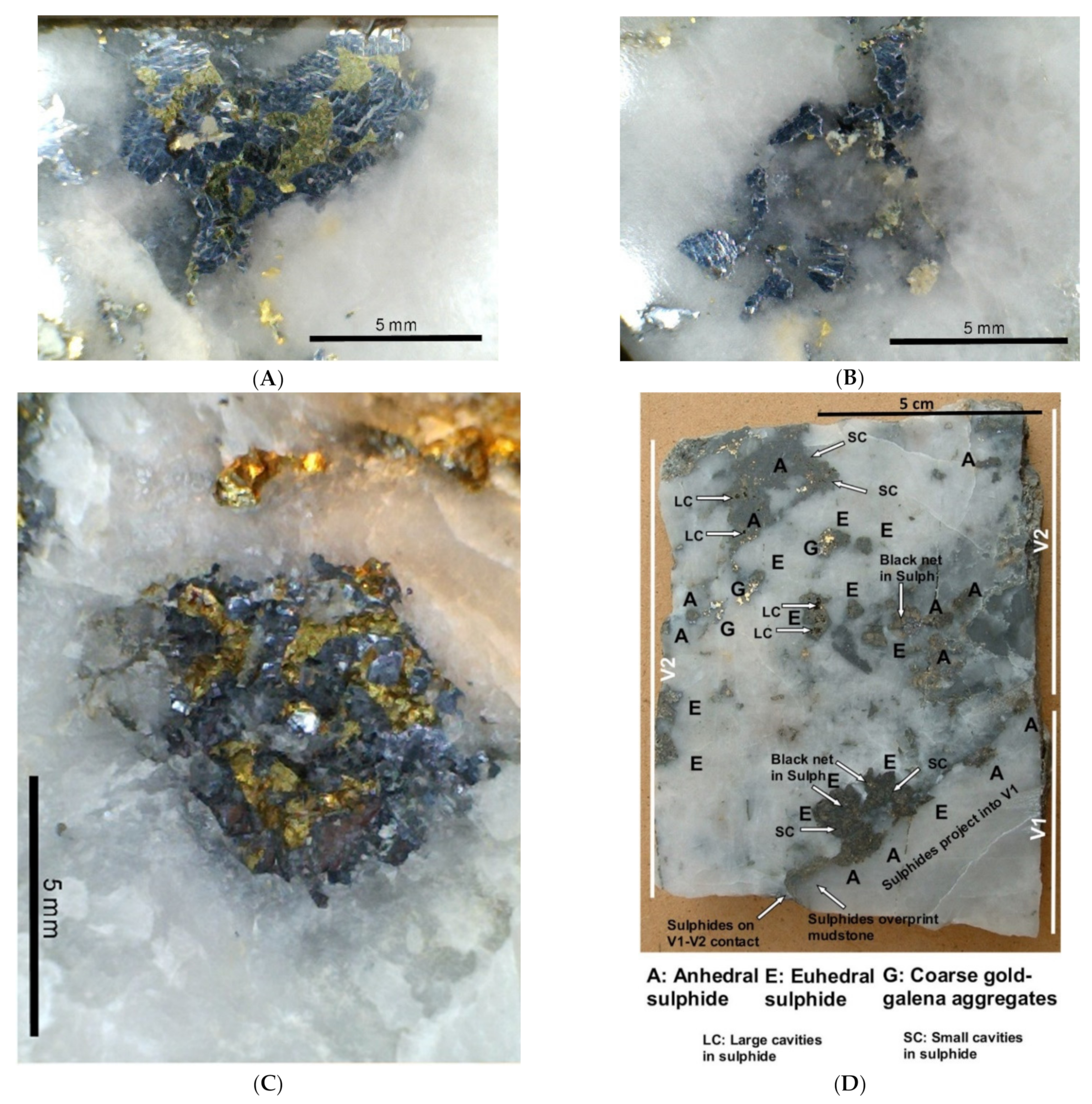


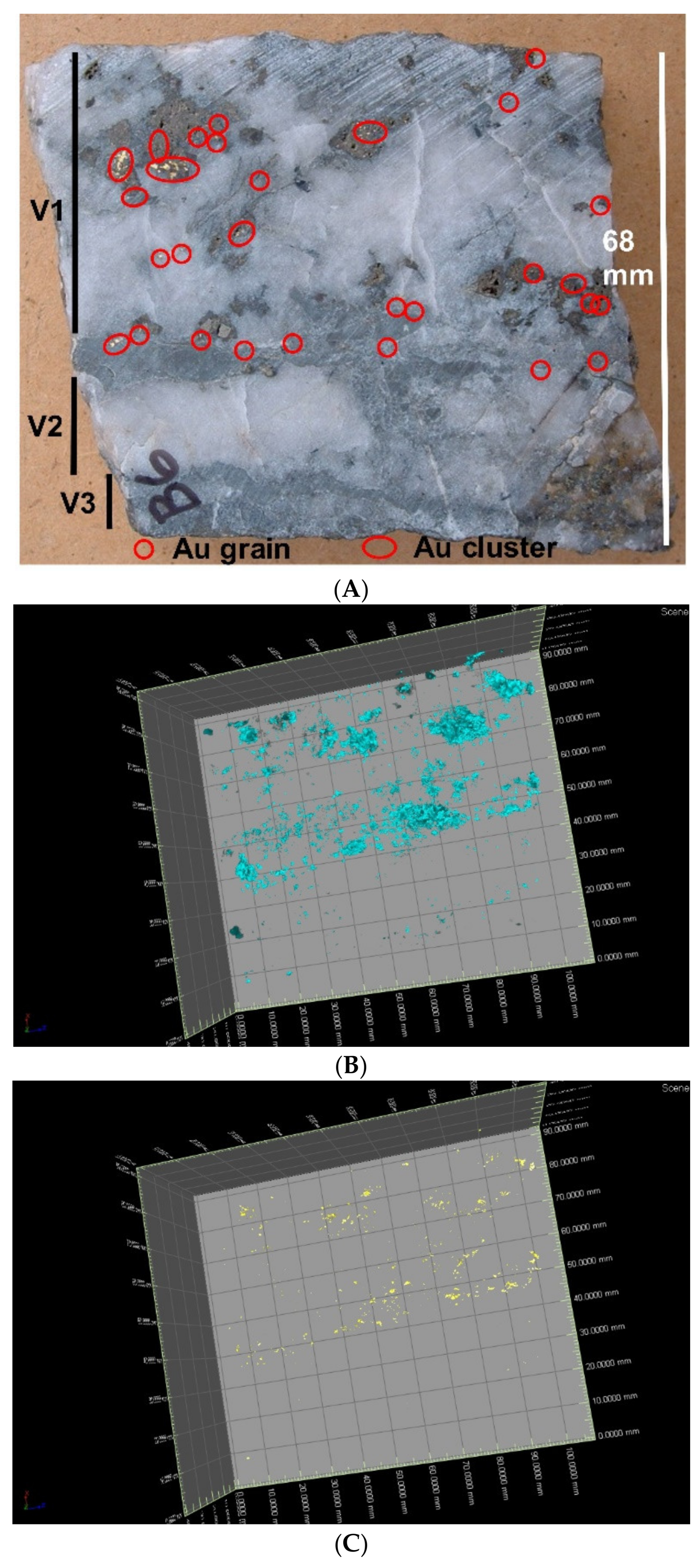
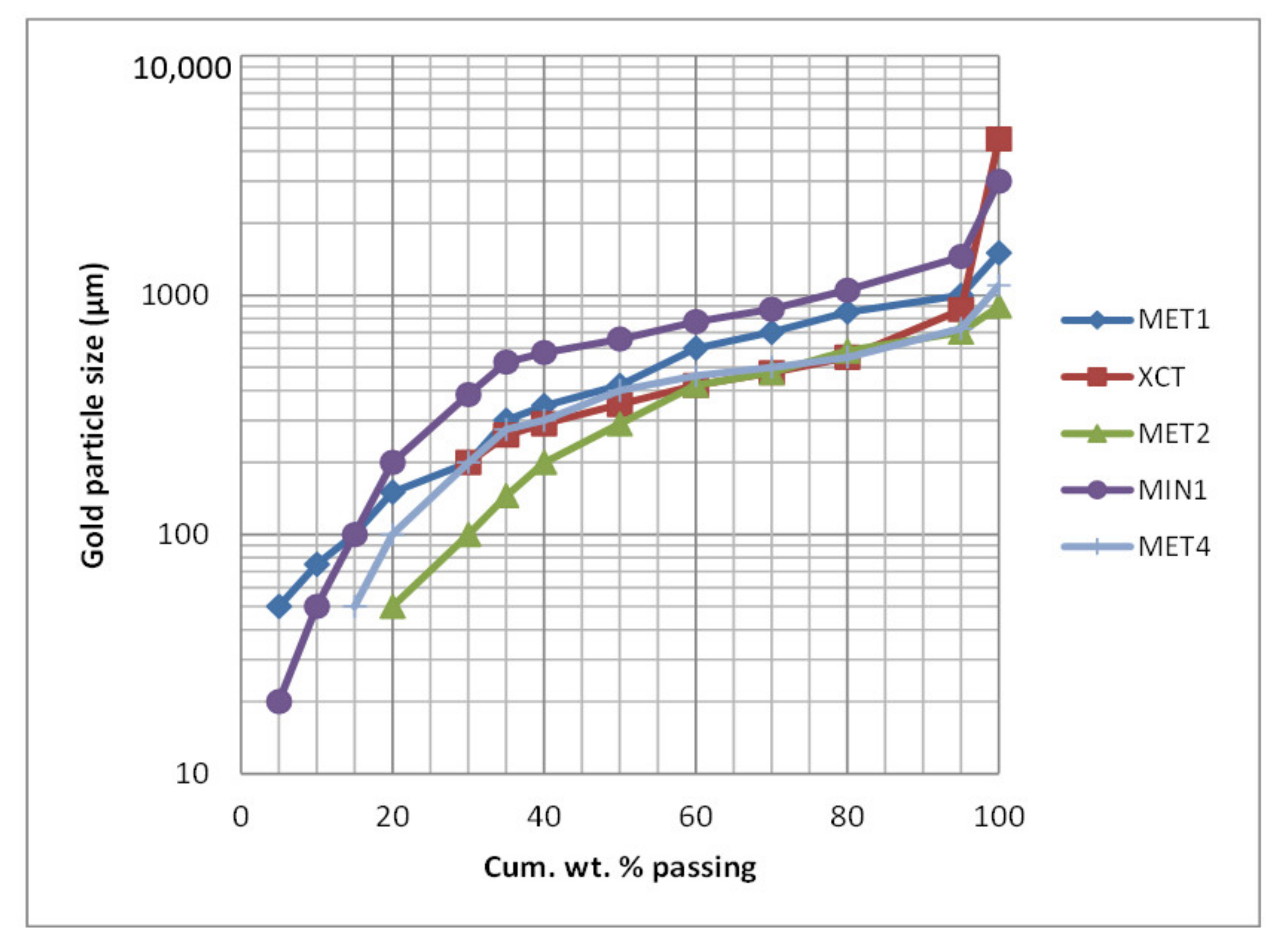

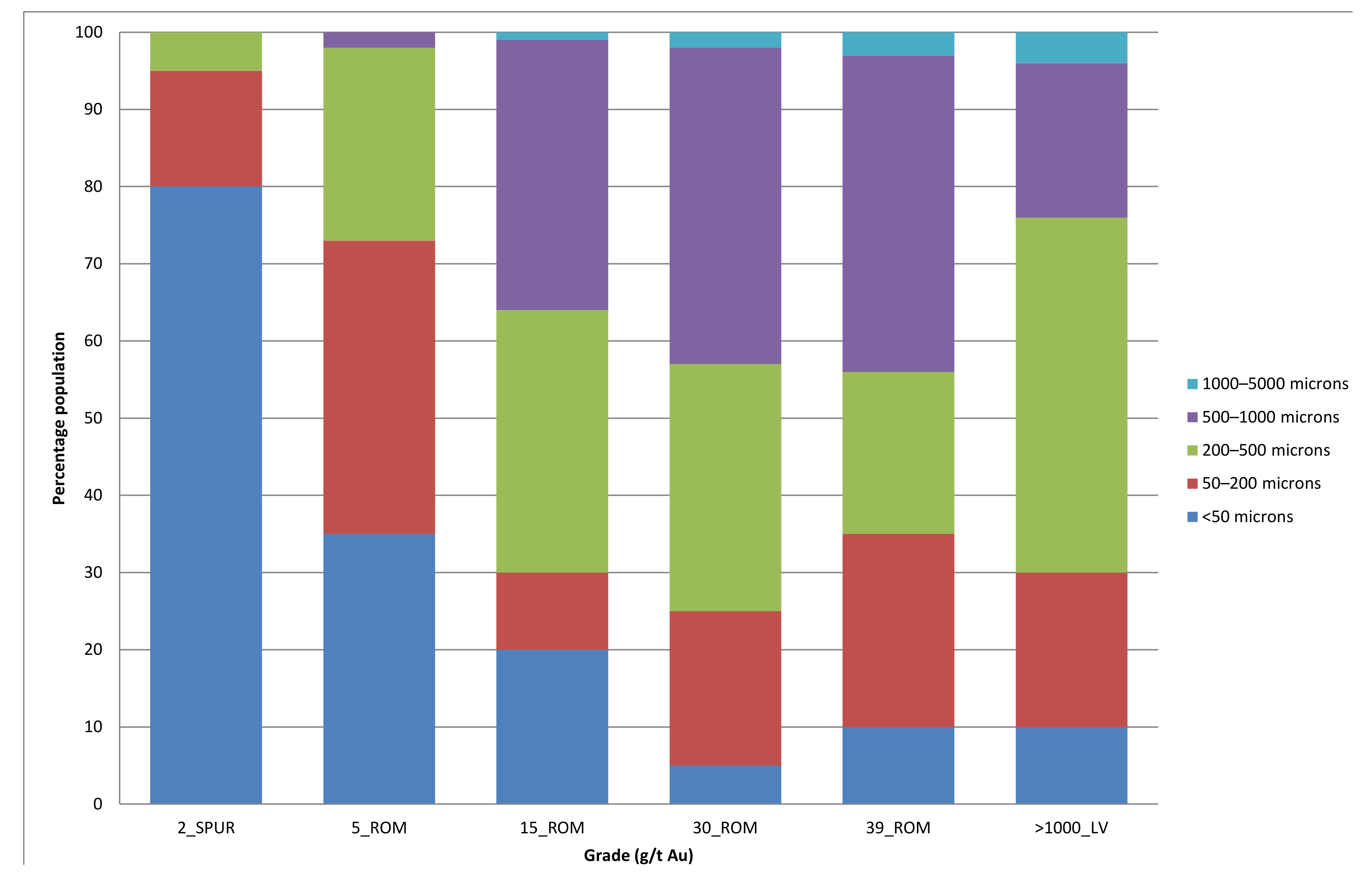
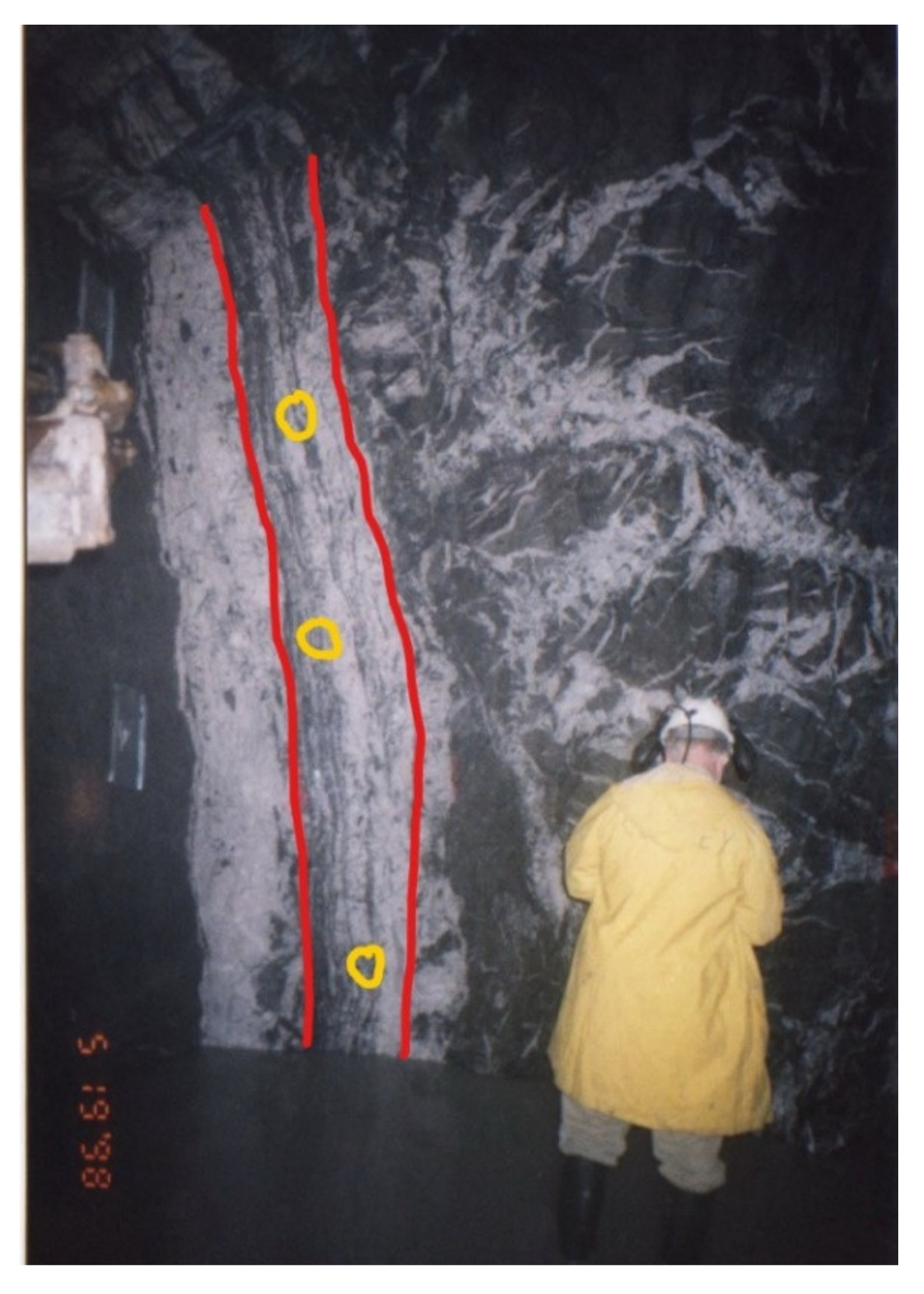
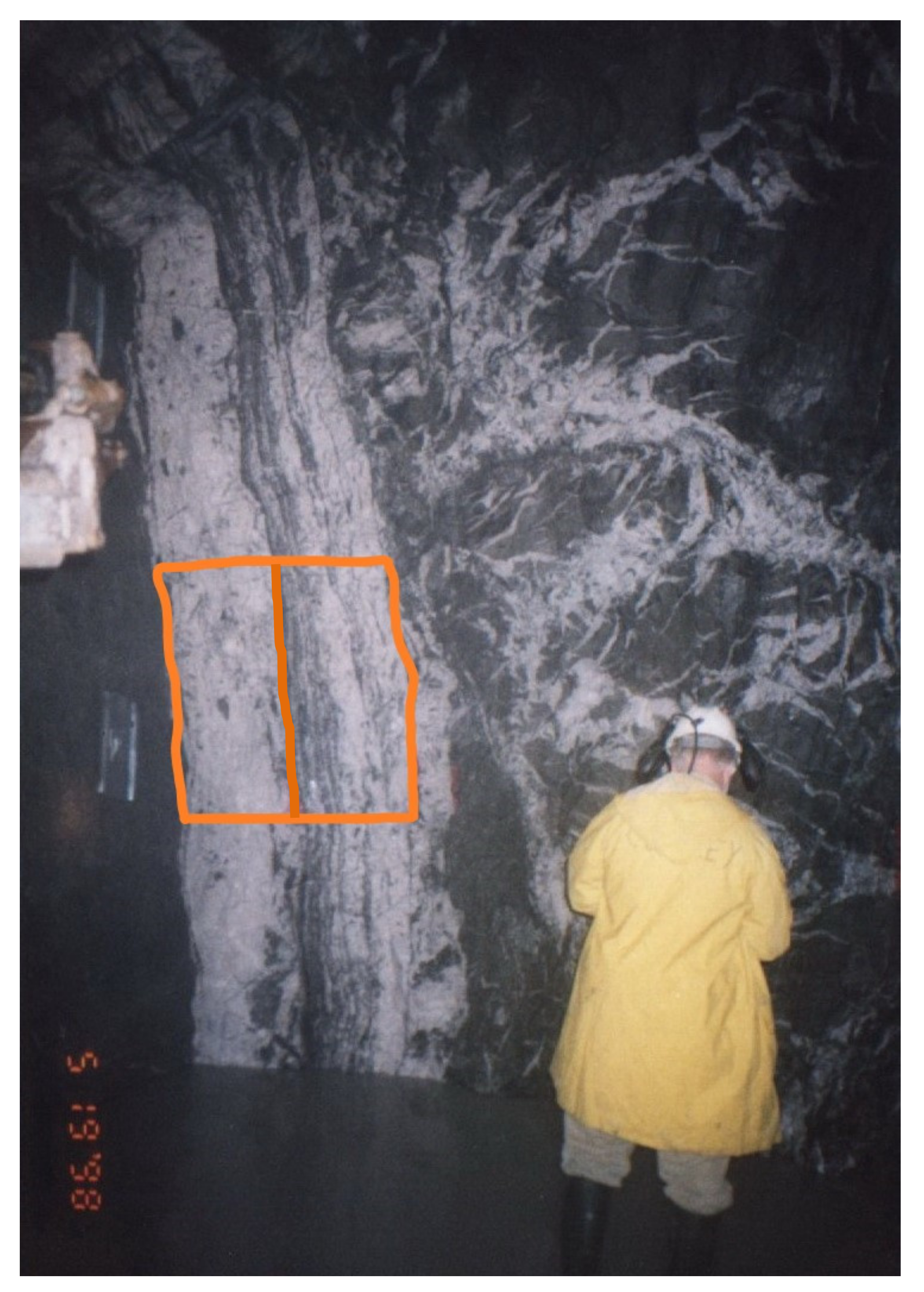
| Sampling Error | Acronym | Error Type | Effect on Sampling | Source of Error | Error Definition |
|---|---|---|---|---|---|
| Fundamental | FSE | Correct Sampling Error (CSE) | Random Errors- Precision Generator | Characteristics of the mineralisation. Relates to Constitution and Distribution Heterogeneity | Grade heterogeneity of the broken lot. FSE does not cancel out and remains even after a sampling operation is perfect. Experience shows that the total nugget effect can be artificially high because sample weights are not optimal. |
| Grouping and Segregation | GSE | Error due to the combination of grouping and segregation of rock fragments in the lot. Once rock is broken, there will be segregation of particles at any scale. | |||
| Delimitation | DE | Incorrect Sampling Error (ISE) | Systematic Errors- Bias Generator | Sampling equipment and materials handling | Incorrect shape of the volume delimiting a sample. |
| Extraction | EE | Incorrect extraction of a sample. Extraction is only correct when all fragments within the delimited volume are taken into the sample. | |||
| Weighting | WE | Collection of samples that are of a comparable support. Samples should represent a consistent mass per unit. | |||
| Preparation | PE | Issues during sample transport and storage (e.g., mix-up, damage), preparation (contamination and/or losses), and intentional (sabotage) and unintentional (careless actions and non-adherence of protocols) human error. | |||
| Analytical | AE | Analytical | Analytical process | Errors during the assay and analytical process, including issues related to rock matrix effects, human error, and analytical machine maintenance and calibration. |
| Quartz Vein Domain | Structural Event (1) | Domain Grade (g/t Au) | Visible Gold | Disseminated Single Particle Gold | <5 mm Gold Clusters | <10 cm Gold Clusters | Reviewed in This Work |
|---|---|---|---|---|---|---|---|
| Core zone | D3A | <5 (mean 2 g/t Au) | No | Rare | No | No | No |
| LV | D3B | 140 (weighted mean) | Common | Common | Common | Yes | MIN; MET; XCT (2) |
| Spur veins | D3A | <5 (mean 2 g/t Au) | Rare | Rare | Rare | No | MET |
| Cumulative Probability Range | Grade Range (g/t Au) | Mean Grade (g/t Au) | Contained Gold |
|---|---|---|---|
| P0–48 | 0.03–20 | 6 | 2% |
| P48–91 | 20–400 | 103 | 31% |
| P91–99 | 400–2000 | 626 | 37% |
| P99–100 | >2000 | 3440 | 30% |
| Level Interval (m RL) | Block | Weighted Mean LV Grade (g/t Au) | Mean LV Thickness (m) |
|---|---|---|---|
| 1129–1155 | 4 | 300 | 0.35 |
| 1050–1129 | 3 | 150 | 0.75 |
| 1032–1050 | 2W | 125 | 0.65 |
| 990–1032 | 2E/1 | 160 | 0.65 |
| 965–990 | 2E/2 | 55 | 0.55 |
| 940–965 | 2E/3 | 6 | 0.50 |
| Laminated Vein Domain | Nugget Effect | Strike Range | Dip Range |
|---|---|---|---|
| Hangingwall | 65% | 8 m | 25 m |
| Footwall | 65% | 9 m | 30 m |
| Data Set | Location | Domain | Source MET Samples (Refer Table 7) | No of Sections | Est. LV Grade (g/t Au) |
|---|---|---|---|---|---|
| MIN1 | Blocks 2E/1, 2W and 3 | SLV | MET4 | 70 | >200 |
| MIN2 | Block 2E/2 | WLV | MET2 and MET3 | 56 | 40–60 |
| Sample ID | Mine Block Location | Testwork Laboratory | Domain | Sample Mass (kg) | Sample Grade (g/t Au) | Grade Type |
|---|---|---|---|---|---|---|
| MET1 | Upper (>990 m RL) | McGill | SLV | 50 | 39.0 | High |
| MET2 | 2E/2 | Cardiff | MLV | 250 | 14.9 | Moderate/BCOG |
| MET3 | 2E/2 | Cardiff | WLV | 250 | 5.2 | Low |
| MET4 | 2E/1, 2W and 3 | Camborne | SLV | 250 | 30.4 | High/ROM |
| MET5 | Various | Camborne | SPUR | 200 | 2.1 | Low |
| Stage | Crush/Grind Step | Gold Concentration | Gold Particle Size Evaluation |
|---|---|---|---|
| 1 | Crush entire sample to −5 mm | Screen product at 2 mm Pan + 2 mm product Pass −2 mm fraction over a Wilfley table | Review each gold concentrate(s) by optical microscopy Screen gold concentrate at 5000; 1000; 500; 200; 50 µm Weigh and assay each fraction to extinction |
| 2 | Crush S1 fraction to −2 mm | Pass entire fraction over a Wilfley table | |
| 3 | Crush S2 fraction to −1 mm | ||
| 4 | Grind S3 fraction to −0.5 mm | ||
| 5 | Grind S4 fraction to −0.2 mm | ||
| 6 | Grind S5 fraction to −50 µm | By assay | Cyanide leach entire fraction; fire assay tails |
| Gold Particle Parameter | Sampling Optimisation | Metallurgical Processing |
|---|---|---|
| Size | Size range and dℓAu | Size range |
| Shape | Shape and range of shape types | Shape and range of shape types |
| Distribution (incl. clustering) | Presence of and degree of clustering (dℓclus) | -- |
| Associations | -- | Associated mineral distribution and degree of encapsulation |
| Sample | Number of Gold Particles Identified | Mean ESD (µm) | Maximum ESD (µm) | P95 ESD (µm) |
|---|---|---|---|---|
| B1–6 and D2–4 | 6463 | 475 | 4500 | 930 |
| B1 | 1050 | 400 | 1300 | 660 |
| B2 | 330 | 650 | 4500 | 1800 |
| B3 | 590 | 510 | 2500 | 1100 |
| B4 | 730 | 500 | 1800 | 985 |
| B5 | 905 | 530 | 2100 | 1060 |
| B6 | 460 | 440 | 1200 | 820 |
| D2 | 755 | 525 | 2500 | 1130 |
| D3 | 880 | 420 | 1500 | 760 |
| D4 | 763 | 425 | 1600 | 675 |
| Method | Limitations |
|---|---|
| Optical mineralogy | Large number of sections required to be representative (1) 2D representation only—stereological effects Gold plucking (loss) during sample preparation/polishing Particle size resolution below microscope capability |
| Scanning electron microscopy/micro-analysis | Large number of sections required to be representative (1) 2D representation only—stereological effects Gold plucking (loss) during sample preparation/polishing Particle size resolution below microscope capability |
| Metallurgical testwork | Potentially unrepresentative primary sample mass Modified gold particles sizes due to comminution—outputs represent minimum gold particle size distribution |
| XCT | High relative cost controls number of samples scanned and thus representativity Computer intensive processing Scanning artefacts Particle size resolution (200 µm in this case) (2) |
| Data Set | Proportion of LV Domain | Type | Method | Indicated Grade (g/t Au) | Percent of Gold >100 µm | Percent of Gold >200 µm | Maximum Gold Particle ESD (µm) | Liberation Diameter—dℓAu (µm) (7) |
|---|---|---|---|---|---|---|---|---|
| (1) MIN1 | 100% SLV | 65 PTS | Reflected light | >200 | 87 | 80 | 3000 | 1450 |
| (2) MIN2 | 100% WLV | 40 PTS | Reflected light | 40–60 | 40 | 30 | 575 | 400 |
| (3) MET1 | Not known, assumed c. 20% | 50 kg sample | GRG test | 39 | 85 | 70 | 1500 | 1000 |
| (4) MET2 | 20% SLV | 250 kg sample | Crush, screen and assay | 15 | 70 | 60 | 900 | 700 |
| (4) MET3 | 20% WLV | 250 kg sample | Crush, screen and assay | 5 | 50 | 25 | 525 | 375 |
| (5) MET4 | 20% SLV | 250 kg sample | Crush, screen and assay | 30 | 80 | 70 | 1000 | 725 |
| (5) MET5 | 100% SPUR | 250 kg sample | Crush, screen and assay | 2 | 11 | 8 | 300 | 250 |
| (6) XCT (raw) | 100% SLV | 9 hand specimens | XCT | 4800 | - | 65 | 4500 | 930 |
| Fraction (µm) | Effective Single Gold Particle Mass (mg) | Fraction Grade (g/t Au) | Percentage Grade of ROM Grade | Est. No. of Gold Particles | Percentage of Particles |
|---|---|---|---|---|---|
| 1000–5000 | 427 | 0.7 | 3% | 2 | <0.01% |
| 500–1000 | 6.12 | 11.9 | 41% | 2000 | 0.04% |
| 200–500 | 0.64 | 7.7 | 26% | 12,000 | 0.2% |
| 50–200 | 0.034 | 6.5 | 22% | 194,000 | 3.7% |
| <50 | 0.0004 | 2.2 | 8% | 5,100,000 | 96.1% |
| Sample | Sample Mass (kg) | XCT Identified Gold | Estimated Head Grade | ||
|---|---|---|---|---|---|
| g/t Au | oz/t Au | g/t Au | oz/t Au | ||
| B1 | 0.49 | 1900 | 61 | 2700 | 87 |
| B2 | 0.25 | 20,900 | 671 | 29,800 | 958 |
| B3 | 0.22 | 9300 | 300 | 13,500 | 429 |
| B4 | 0.75 | 2250 | 72 | 3200 | 103 |
| B5 | 0.72 | 3000 | 98 | 4300 | 140 |
| B6 | 0.43 | 1500 | 47 | 2100 | 68 |
| D2 | 0.26 | 10,600 | 342 | 15,200 | 489 |
| D3 | 0.40 | 2600 | 84 | 3700 | 120 |
| D4 | 0.17 | 5900 | 189 | 8400 | 270 |
| ALL | 3.69 | 4800 | 156 | 6900 | 222 |
| Parameter/Feature | Value | Comment |
|---|---|---|
| Mineralogical associations | Galena and arsenopyrite | Strong association between gold and galena. Intimate mixed particle and/or close association |
| Gold particle abundance (grade) | 3000–30,000 g/t Au | Confirms extremely high grade of samples |
| Particle orientation | Poor | Elongate or plate fragments rare, so fabrics local |
| Gold particle shape | Equidimensional | Generally equidimensional, sometimes rounded or complex forms |
| Gold particle size range | 200–4500 µm 5–50 µm | Leicester University and NHM London scans ANU plug scan |
| Liberation diameter | 980 µm (raw) 850 µm (corrected) | Values relatively consistent with metallurgical and mineralogical testwork |
| Gold particle clustering on XCT sample scale | Up to 5000 µm >10,000 µm | Smaller ROM grade clusters Larger clusters related to very high grades |
| Gold particle population | Very coarse population >1000 µm | Log-probability plot break point at approx. 1000 µm. Lower break point around 100 µm from MET/MIN data |
| Gravity recoverable gold | Very high | Raw data indicate dominant coarse gold (>200 µm) that has strong GRG potential Gold association with galena flags potential concentration of galena within the gold gravity process. This was indeed noted during production. |
| Grade Type | Face Grade (1) (g/t Au) | LV Grade (1) (g/t Au) | Liberation Diameter (6) (dℓAu—µm) | Face Diluted RSM (11,12) at 68% CL (kg) | LV-Only RSM (11,12) at 68% CL (kg) |
|---|---|---|---|---|---|
| Very high grade (c) | 150 (2) | 740 | 850 | 5 | 5 |
| Very high grade | 150 (2) | 740 | 3000 | 45 | 10 |
| High grade | 39 (3) | 185 | 850 | 5 | 5 |
| High grade (c) | 39 (3) | 185 | 3000 (7) | 150 | 35 |
| ROM | 29 (4) | 157 | 850 | 6 | 5 |
| ROM (c) | 29 (4) | 157 | 1500 (8) | 30 | 5 |
| ROM (c) | 29 (4) | 157 | 3000 (7) | 200 | 45 |
| BCOG | 15 (5) | 80 | 750 | 8 | 5 |
| BCOG (c) | 15 (5) | 80 | 1500 | 100 | 10 |
| Low grade | 5 (9) | 15 | 750 | 10 | 7 |
| Background grade | 4–6 (10) | 5 | 375 | 5 | 5 |
| Very low grade | 1 | 5 | 375 | 13 | 5 |
| Low (spurs only) | 2.5 | - | 250 | 5 | 5 |
| Approx. Proportion of UHG Clusters | LV Grade (g/t Au) | Face Grade (g/t Au) | 1 Cluster (5) ESD 12.2 mm | ½ Cluster (5) ESD 9.6 mm | ⅓ Cluster (5) ESD 8.4 mm |
|---|---|---|---|---|---|
| Representative Sample Mass (t) | |||||
| 1% | 80 | 15 (1) | 26 | 13 | 9 |
| 1.5% | 140 (3) | 25 | 18 | 9 | 6 |
| 2% | 157 | 29 (2) | 14 | 7 | 4 |
| 5% | 365 | 65 | 6 | 3 | 2 |
| 10% | 710 | 125 | 3 | 2 | 1 |
| 15% | 1050 | 183 | 2 | 1 | 1 |
| 19% | 1300 | 225 (4) | 1 | 1 | 0.5 |
| Approx. Proportion of UHG Clusters | LV Grade (g/t Au) | Face Grade (g/t Au) | 1 Cluster (2) ESD 12.2 mm | ½ Cluster (2) ESD 9.6 mm | ⅓ Cluster (2) ESD 8.4 mm |
|---|---|---|---|---|---|
| Representative Sample Mass | |||||
| 5% | 365 | 65 | 1 t | 525 kg | 350 kg |
| 10% | 710 | 125 | 550 kg | 300 kg | 200 kg |
| 15% | 1050 | 183 | 400 kg | 200 kg | 125 kg |
| 18.5% | 1300 | 225 (1) | 300 kg | 150 kg | 100 kg |
| Domain | LV Grade (g/t Au) | Scenario | dℓAu (µm) | Primary Sample Mass (kg) | FSE |
|---|---|---|---|---|---|
| Laminated vein | 750 | Very high-grade LV | 3000 [c] | 5–7 | ±11% |
| 850 | ±5% | ||||
| 140 | Mean LV to give mean face | 850 | 5–7 | ±10% | |
| 1500 [c] | ±16% | ||||
| 80 | 15 g/t Au BCOG face | 850 | 5–7 | ±13% | |
| 1500 [c] | ±35% | ||||
| 15 | 5 g/t Au low grade face | 850 | 5–7 | ±32% | |
| 1500 [c] | ±48% | ||||
| Spur vein | 2.5 | Mean | 250 | 5–7 | ±31% |
| Duplicate Type | Explanation | Number | Component Error | Component Relative Error (RSV) | Proportion of Total |
|---|---|---|---|---|---|
| Field | Chip-channel sample | 54 | Sampling | ±77% | 69% |
| Coarse | Laboratory split after crushing | 37 | Preparation | ±51% | 30% |
| Assay | Assay | Est. | Analytical | ±10% | 1% |
| Total | - | - | Total | ±92% | 100% |
| Duplicate Type | Explanation | Number | Component Error | Component Relative Error (RSV) | Proportion of Total |
|---|---|---|---|---|---|
| Field | Chip-channel sample | 45 | Sampling | ±27% | 50% |
| Coarse | Laboratory split after crushing | 37 | Preparation | ±25% | 44% |
| Assay | Assay | Est. | Analytical | ±10% | 7% |
| Total | - | - | Total | ±38% | 100% |
| Protocol | Protocol Steps |
|---|---|
| 1 |
|
| 2 |
|
| Domain | LV Grade (g/t Au) | Scenario | dℓAu (µm) | Primary Sample Mass (kg) | Protocol 1: FSE | Protocol 2: FSE |
|---|---|---|---|---|---|---|
| Laminated vein (1 m × 0.7 m sample) | 750 | Very high-grade LV | 850 | 5–7 | ±2–3% | ±0% |
| 3000 [c] | ±6–7% | ±0% | ||||
| 140 | Mean LV to give mean face | 850 | 5–7 | ±6–7% | ±0% | |
| 1500 [c] | ±9–10% | ±0% | ||||
| 80 | 15 g/t Au BCOG face | 850 | 5–7 | ±7–9% | ±0% | |
| 1500 [c] | ±11–13% | ±0% | ||||
| 15 | 5 g/t Au low grade face | 850 | 5–7 | ±17–20% | ±0% | |
| 1500 [c] | ±26–31% | ±0% | ||||
| Spur vein (3 m × 0.9 m samples) | 2.5 | Mean | 250 | 5–7 | ±17–20% | ±0% |
| Location | Face | Laminated Vein-Only | ||
|---|---|---|---|---|
| Upper mine levels (>990 m RL) | UHG[c] >65 g/t Au | <6 t | UHG[c] >365 g/t Au | <1 t |
| HG[c] 39 g/t Au | 150 kg | HG[c] 185 g/t Au | 35 kg | |
| ROM[c] 29 g/t Au | 30 kg | ROM[c] 157 g/t Au | 5 kg | |
| Lower mine levels (<990 m RL) | ROM[c] 29 g/t Au | 200 kg | ROM[c] 157 g/t Au | 45 kg |
| BCOG 15 g/t Au | 8 kg | BCOG 15 g/t Au | 5 kg | |
| LG 5 g/t Au | 10 kg | LG 15 g/t Au | 7 kg | |
| VLG 1 g/t Au | 13 kg | VLG 5 g/t Au | 5 kg | |
| Domain | LV Grade (g/t Au) | Scenario | dℓAu or dℓclus (µm) | Primary Sample Mass (kg) | Protocol 1: FSE | Protocol 2: FSE |
|---|---|---|---|---|---|---|
| Laminated vein (1 m × 0.7 m sample) | 750 | HG to give face grade of 150 g/t Au | 850 | 7–14 | ±2–3% | ±0% |
| 3000 [c] | ±4–6% | ±0% | ||||
| 140 | Mean face grade of 29 g/t Au | 850 | 7–14 | ±4–6% | ±0% | |
| 1500 [c] | ±6–9% | ±0% | ||||
| 80 | BCOG face grade of 15 g/t Au | 850 | 7–14 | ±5–7% | ±0% | |
| 1500 [c] | ±8–11% | ±0% | ||||
| 15 | Low face grade of 5 g/t Au | 850 | 7–14 | ±12–17% | ±0% | |
| 1500 [c] | ±19–26% | ±0% | ||||
| Spur veins (0.5 m samples) | 2.5 | Mean | 250 | 1–2 | ±0% | ±0% |
| Protocol | Estimated Cost per Sample (A$) | Single Sample Total Precision | Single Sample Laboratory to Assay Precision | Four Sample Precision Based on a Single Development Round Informed by Four Samples | |
|---|---|---|---|---|---|
| Original | 6 kg sample to CL1000 | $85 | ±92% (1) | ±51% (1) | ±46% |
| 6 kg sample to SFA1000 | $100 | ±92% (2) | ±50% (2) | ±46% | |
| Recommended | Protocol 2: 11 kg sample to PA11000 | $210 | <±15% (3) | <±5% (3) | <±8% (3) |
| Protocol 1: 11 kg sample t PA5500 | $125 | <±25% (3) | <±20% (3) | <±13% (3) | |
Publisher’s Note: MDPI stays neutral with regard to jurisdictional claims in published maps and institutional affiliations. |
© 2021 by the authors. Licensee MDPI, Basel, Switzerland. This article is an open access article distributed under the terms and conditions of the Creative Commons Attribution (CC BY) license (https://creativecommons.org/licenses/by/4.0/).
Share and Cite
Dominy, S.C.; Platten, I.M.; Glass, H.J.; Purevgerel, S.; Cuffley, B.W. Determination of Gold Particle Characteristics for Sampling Protocol Optimisation. Minerals 2021, 11, 1109. https://doi.org/10.3390/min11101109
Dominy SC, Platten IM, Glass HJ, Purevgerel S, Cuffley BW. Determination of Gold Particle Characteristics for Sampling Protocol Optimisation. Minerals. 2021; 11(10):1109. https://doi.org/10.3390/min11101109
Chicago/Turabian StyleDominy, Simon C., Ian M. Platten, Hylke J. Glass, Saranchimeg Purevgerel, and Brian W. Cuffley. 2021. "Determination of Gold Particle Characteristics for Sampling Protocol Optimisation" Minerals 11, no. 10: 1109. https://doi.org/10.3390/min11101109
APA StyleDominy, S. C., Platten, I. M., Glass, H. J., Purevgerel, S., & Cuffley, B. W. (2021). Determination of Gold Particle Characteristics for Sampling Protocol Optimisation. Minerals, 11(10), 1109. https://doi.org/10.3390/min11101109







